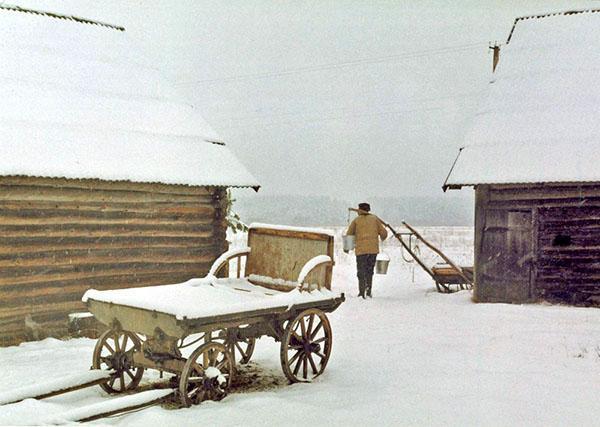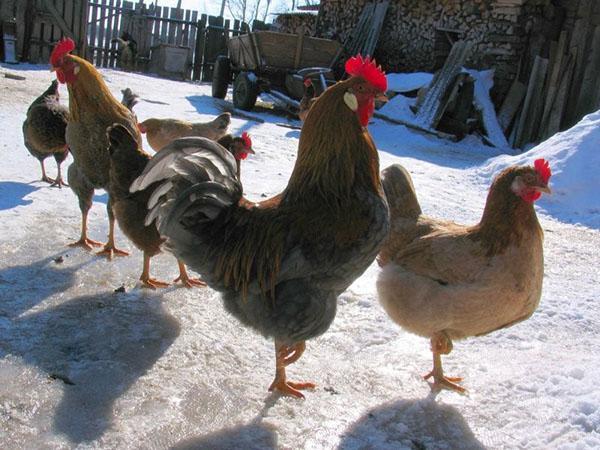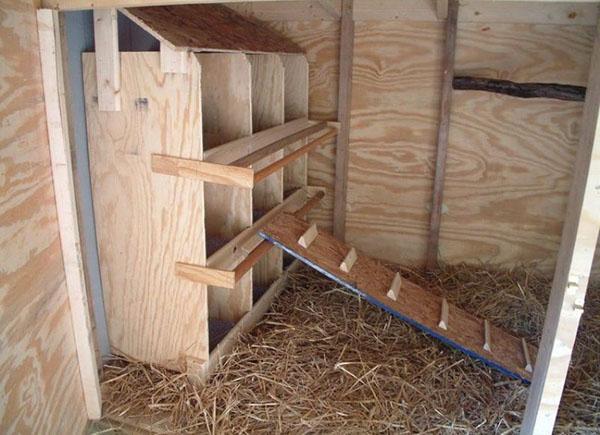Incessant hassle at the farm in the January cold
 Despite the fact that January is the golden mean of winter, summer residents do not have to rest on their laurels. Especially for those who care for chickens, rabbits, piglets, goats and nutria. I want to take off my hat in front of them, because the chores in the household yard are the most responsible.
Despite the fact that January is the golden mean of winter, summer residents do not have to rest on their laurels. Especially for those who care for chickens, rabbits, piglets, goats and nutria. I want to take off my hat in front of them, because the chores in the household yard are the most responsible.
In one famous book it is written that a righteous person cares about the life of his livestock. Indeed, this hard work is worthy of sincere praise. What kind of work is required to be done on the yard when it's January outside? Let's try to figure it out.
Chickens are a bird worthy of attention

 In the northern latitudes of Russia, where frosts crack outside the window for several months in a row, birds need warm rooms. In January, caring chicken owners make additional insulation for their pets. In places where winters are much milder, it is necessary to change the flooring more often and to close the gaps arising from weather conditions. This will help maintain the optimal temperature for the chickens to overwinter. As a result, they will not get sick and will thank the owners with fresh eggs.
In the northern latitudes of Russia, where frosts crack outside the window for several months in a row, birds need warm rooms. In January, caring chicken owners make additional insulation for their pets. In places where winters are much milder, it is necessary to change the flooring more often and to close the gaps arising from weather conditions. This will help maintain the optimal temperature for the chickens to overwinter. As a result, they will not get sick and will thank the owners with fresh eggs.
 In winter, chickens need not only warmth, but also a balanced diet, consisting of the following feeds:
In winter, chickens need not only warmth, but also a balanced diet, consisting of the following feeds:
- Vitamins... They are obtained from sprouted grains. To do this, it is sown in boxes, and when green shoots appear, they are cut and given to the birds.
- Calcium... Wise summer residents do not throw eggshells into the trash, but grind and give them to chickens.
- Boiled potatoes... It is considered a source of protein, is well absorbed and therefore very useful during the winter cold.
Such a healthy feed in January will prepare the birds for the spring brood of chickens, which means that the chickens will not run out of time in the farm.
Rabbits are not only valuable fur
 With the arrival of January, rabbit owners understand that winter is not over yet and there are many cold days ahead. Especially if the animals are kept outdoors. First of all, you need to take care of the insulation of the cells. For this, various improvised items are used, including the following:
With the arrival of January, rabbit owners understand that winter is not over yet and there are many cold days ahead. Especially if the animals are kept outdoors. First of all, you need to take care of the insulation of the cells. For this, various improvised items are used, including the following:
- straw;
- felt fabric;
- foam sheets;
- polycarbonate.
 To keep the rabbits warm, the mesh floor in the cage is covered with dry straw. Thick wooden pallets can also be placed there. All cracks must be closed to protect the rabbits from the cold winter winds. To do this, use polycarbonate, foam or plywood.
To keep the rabbits warm, the mesh floor in the cage is covered with dry straw. Thick wooden pallets can also be placed there. All cracks must be closed to protect the rabbits from the cold winter winds. To do this, use polycarbonate, foam or plywood.
In regions where there are severe frosts, rabbitries are covered with old wadded blankets.
Despite the January cold, it is at this time that it is time to think about offspring. In order for rabbits to appear strong and healthy, you must carefully examine your pets before mating. Bunnies who previously refused to feed their cubs or even ate them are not suitable for the new generation.  The best option is healthy, well-fed, but not fatty individuals that have reached puberty. Usually they should be over 3.5 months old. To get good offspring, it is better to breed mature animals: the male is 4 or 5 months old, the female is about 8.
The best option is healthy, well-fed, but not fatty individuals that have reached puberty. Usually they should be over 3.5 months old. To get good offspring, it is better to breed mature animals: the male is 4 or 5 months old, the female is about 8.
Should not be used for mating animals that show any discomfort. Any irritation, rash, or sluggish behavior indicates an internal illness.
When the choice and the deed are made, pregnant rabbits are placed in separate uterine cells. They are also insulated with styrofoam, straw and blankets. If there are severe frosts on the street for a long time, it is advisable to transfer the mother plant to a dry room.
 In whatever region rabbits are kept, they all need good nutrition. If the owners thought about this in the summer, then the rabbits will see the following food on their "table":
In whatever region rabbits are kept, they all need good nutrition. If the owners thought about this in the summer, then the rabbits will see the following food on their "table":
- juicy carrots;
- fodder beet;
- Jerusalem artichoke;
- hay;
- tree branches;
- compound feed.
Pregnant individuals are supposed to be given vitamins daily in January. It is for this purpose that special compound feeds have been created, with a full range of nutrients.
Picky nutria in winter
 Cute animals that came to us from South America - nutria, have long become the favorites of the household. They wonderfully take root in an area where frosts crack in winter and a lot of snow. And also in warmer latitudes of the planet.
Cute animals that came to us from South America - nutria, have long become the favorites of the household. They wonderfully take root in an area where frosts crack in winter and a lot of snow. And also in warmer latitudes of the planet.
 If we live in the northern part of Russia, in January the nutria should have been living in an insulated room for a long time. For this, summer residents pre-insulate the shed on the farm yard in order to place animals there in winter. In addition, a dense flooring of dried grass or straw is placed in each house. This is how the tail and delicate paws of animals protect from frost.
If we live in the northern part of Russia, in January the nutria should have been living in an insulated room for a long time. For this, summer residents pre-insulate the shed on the farm yard in order to place animals there in winter. In addition, a dense flooring of dried grass or straw is placed in each house. This is how the tail and delicate paws of animals protect from frost.
It has been observed that homemade nutria can do without bathing. Therefore, in places where winters are cold, it is not necessary to put a vat of water for them.
In regions with milder winters, the cages can only be insulated if a suitable barn is not available. In addition, at above-zero temperatures, you can arrange for the nutria a bathing holiday in a wide vat of water. Although they will not say "thank you", the owners will be pleased to watch the happy animals.
To breed successfully nutria, in January, it is necessary to select animals suitable for mating. When determining a male, you should pay attention to his parents. In general, they should be flawless: excellent outer sheen of the fur, a painless body, an active lifestyle.  If males are picked up, they are separated into a free cage and a calm female is placed next to them. Those individuals who actively "flirt" with nutria are ready to produce high-quality offspring. On average, breeding males are at least 7 months old.
If males are picked up, they are separated into a free cage and a calm female is placed next to them. Those individuals who actively "flirt" with nutria are ready to produce high-quality offspring. On average, breeding males are at least 7 months old.
When choosing a male, it is advisable to observe his vital activity. If he is inactive, the females will beat him, aggressive - he can injure the skin of the female nutria. Therefore, the choice falls on the best animals.
When picking up a female, you should pay attention to her health. Nutria should have a nice coat, eat well and be free from visible damage. According to her behavior, the degree of desire to mate is determined.  Usually during this period, the female actively runs around the cage, paddles with her forepaws, eats poorly and often urinates. Her genitals become swollen and scarlet. In addition, when meeting with a male, nutria sniffs him and follows him around the house. Such signs indicate the readiness of the female to mate.
Usually during this period, the female actively runs around the cage, paddles with her forepaws, eats poorly and often urinates. Her genitals become swollen and scarlet. In addition, when meeting with a male, nutria sniffs him and follows him around the house. Such signs indicate the readiness of the female to mate.
 It is important to try to feed the nutria with high-quality food in January. Their diet includes various root crops, corn, pumpkin, grains. They also do not refuse hay, barley straw or sunflower. They love to eat Jerusalem artichokes. Although during the winter cold the nutria do not eat as actively as in the summer, one should not deprive them of the pleasure of eating their favorite “dishes”.
It is important to try to feed the nutria with high-quality food in January. Their diet includes various root crops, corn, pumpkin, grains. They also do not refuse hay, barley straw or sunflower. They love to eat Jerusalem artichokes. Although during the winter cold the nutria do not eat as actively as in the summer, one should not deprive them of the pleasure of eating their favorite “dishes”.
Of course, not only chickens, rabbits and nutria live in the farm. Many rural workers raise piglets, goats and cows. They try to make every effort to make the animals feel comfortable all year round. And January is a wonderful start for well-coordinated work at the farm.